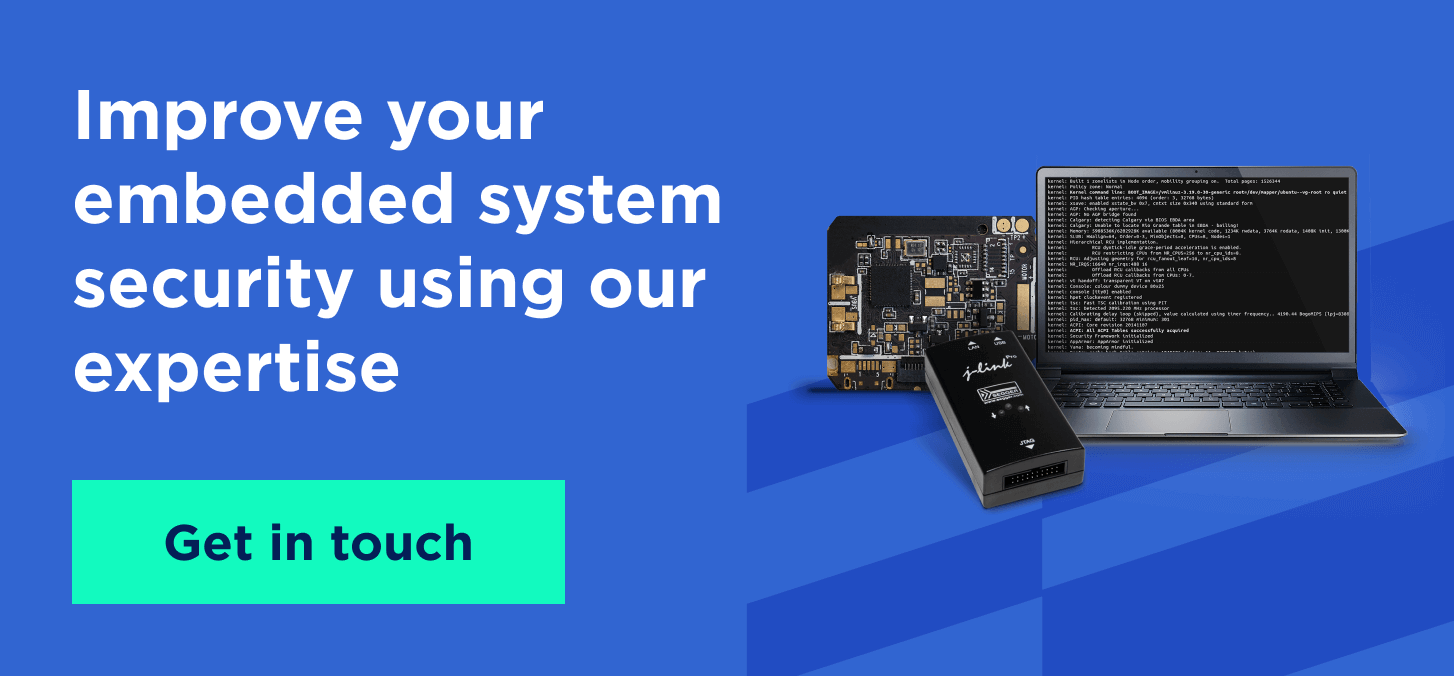Did you know that 32% of all firmware analyzed by Microsoft contained at least 10 known critical vulnerabilities? This basically means embedded systems are an increasingly popular target among cybercriminals, making security a top priority for embedded engineers who design, develop, and deliver your solution.
Even after your embedded system is launched, it is vital to ensure its continuous support and improvement to address the latest security risks and prevent their intrusion into your solution.
Keep reading to learn about the importance of secure embedded systems, what vulnerabilities you should be aware of, and how to ensure high-quality protection for embedded system hardware and software.
What is embedded system security?
Embedded system security refers to concepts and techniques aiming at protecting software and hardware components from malicious actions and unauthorized data access. It encompasses such measures as data encryption, secure communication protocols, physical security, and secure boot processes.
Before designing or redesigning embedded system architecture, we recommend setting up a security policy to assess all potential risks and implement preventive measures in an early development stage. The policy should cover your product's specifics, including device communication and data transmission flow, network security requirements, and the types of data the system stores. This approach applies to embedded systems of any type and purpose.
Further, we’ll determine what embedded security levels exist, why each is critical, and how to predict and avoid security vulnerabilities while developing embedded solutions.
Levels of embedded system security: software and hardware
Embedded system security is defined by these key components — user authentication, network authorization, integrity, and data encryption for complete confidentiality.
When considering the security of your embedded systems, it is essential to keep in mind the two main types of embedded system security: software security features and hardware security.
Software security
Embedded system software is vulnerable to external malicious attacks anytime — whether it’s during system initiation or operation. Attackers don’t need physical access to your embedded system to harm its performance or steal data. That's why security measures like device and network authentication, data spoofing, and input validation should be implemented during the development stage.
Hardware security
Physical vulnerabilities of your embedded system are directly related to unauthorized access to the locations where your devices or equipment are placed. It is also related to memory technology, key stores, system code, and data stored on the devices. This security threat is most often caused by unauthorized users' access to poorly set security systems, including locks, cameras, motion detection sensors, and so on.
Importance of security in embedded systems
Embedded system security is critical to ensuring uninterrupted and stable task execution. In this context, it is grounded on the CIA principle, which stands for confidentiality, integrity, and availability.
These three factors ensure robust protection for your embedded solution on both hardware and software levels. Let's consider the meaning and importance of each concept for your system security.

Confidentiality
The confidentiality concept oversees the protection of sensitive information collected and stored within your embedded software. It mandates that only authorized parties can access data in your network, ensuring encrypted information transitions from the devices to the storage through secure communication protocols. This helps avoid unauthorized access and data leakage.
Integrity
Integrity ensures that data-related system operations are reliable and executed as expected. In case of unauthorized access, an attempt to tamper, or system interference itself, this security concept helps detect malicious actions or safety risks to ensure the data hasn't been breached.
Availability
Availability is in charge of providing uninterrupted access to system data for authorized users. Clearly, it is necessary for regular monitoring of embedded system operation as well as access to a system during malicious operations leading to hardware failure or embedded software attacks.
Making data available for authorized users during a cyberattack gives them the capability to help the embedded solutions withstand an attack and find quick solutions to prevent a data breach.

Top 4 embedded system security vulnerabilities
The majority of embedded system security threats take their roots in the specifics of embedded functionality and continuous internet connection. Eventually, these basic reasons cause various security vulnerabilities, which we will examine further.
1. Data privacy violation
Any data stored in embedded systems is exposed to the risk of being accessed by unauthorized users, which can lead to data leakage or loss. This applies to all types of data stored on your system, from personal data to sensitive business information that is critical to your company's operation.
2. Incorrect input data validation
If an embedded system requires users to provide input, it may cause another embedded system cyber security risk. A malicious user or process might access unforeseen information, leading to crashing apps, using up too many resources, leaking confidential data, running malicious commands, or changing the system operation flow.
3. Incorrect user authentication
Improperly set authentication for users and processes becomes a trigger for cyber crimes. It means unauthorized users can easily bypass the authentication process by guessing the password, stealing and using the credentials, or changing the existing password.
4. Obsolete hardware components
Another security threat to consider is using obsolete hardware components in your embedded system without regular updates. This eventually leads to easier access for unauthorized users, putting at risk the entire IT infrastructure. It is essential to monitor components approaching the end of life and plan their timely replacement with the up-to-date ones.
Overall, being educated on the latest security threats will help predict and prevent these risks for your system. The challenges we listed above are well-known weaknesses you should consider while building and maintaining your embedded system.
Cybercriminals keep adjusting their methods to break your system's security. To resist the emerging types of attacks, cyber security for embedded systems keeps evolving as well, so make sure to keep an eye on the latest security developments.
Best strategies for developing secure embedded systems
Embedded system security strategy needs continuous support and improvement. You can request setting up security measures in the initial development stages, like architecture design, or you can opt for implementing additional security protection to your existing infrastructure.
We compiled a list of security best practices for embedded solutions that will allow you to reach high level of security.

Implement data encryption instruments
Securing communication and data transfer is pivotal to ensuring stable embedded system operation. However, all data types collected, stored, and transferred within your embedded solution must be completely encrypted.
Integrating encryption algorithms is helpful in protecting sensitive information, even if data leakage or theft occurs. Data encryption uses cryptographic keys to unlock data, which also have to be regularly updated to maintain their security.
OTA updates
Considering OTA update functionality at the software architecture design stage is essential. If you already have an embedded system, you can easily opt for integration of OTA updates into your existing solution. Along with regular firmware security updates, this mechanism checks whether the new update is secure and authenticated for installation within your firmware.
Compliance with industry security standards and regulations
Compliance of embedded systems with the necessary industry standards and regulations is the first critical step towards ensuring their comprehensive security. When looking for your future tech partner or switching to another vendor, check out the certifications and compliance these companies possess.
Among these certifications and industry-specific knowledge are ISO 27001, ISO 9001, ISO 13495 for healthcare, ISO 26262 for automotive, HIPAA, DiGA, and others. Based on our own experience, each of these standards requires annual audits to confirm the company's processes are established and follow all the regulations.
Constant management and updates of security measures
Establishing security measures for your embedded system a single time is not sufficient. Along with regular firmware and hardware component updates, the ways to measure your security should also be continuously reviewed and upgraded.
Holding vulnerability tests helps identify potential risks and become aware of emerging security issues you may encounter. That's how you can find efficient methods to implement and hold security testing to defend your embedded solution from cyber attacks.
Secure hardware environment
As we previously mentioned, your embedded device’s security is at the same risk as your data. When measuring the security of your embedded system, it is important to consider the possibilities of hardware tampering and enable early detection of attempts of unauthorized access to your equipment.
Wrapping up
Security is a crucial component of your embedded system. Thus, make sure to consider it as early as possible during the design and development of your system. This way, you’ll ensure your embedded system operates as expected. It will also help you minimize potential hardware and software security risks by implementing protection techniques to prevent them.
At Lemberg Solutions, security is at the core of our embedded development services, whether it relates to the solution we develop or the approach to the development life cycle in general. As an ISO 27001-certified vendor, we have established information security management on projects where only authorized engineers and team members can access project documentation.

We also provide risk management for each embedded system developed, ensuring it complies with data security and industry-related standards. It helps our clients predict all potential risks they may face within their industry and consider them while designing the embedded system architecture.
Feel free to contact our experts to share the embedded system security challenges you face and get an action plan on how to resolve them effectively.



